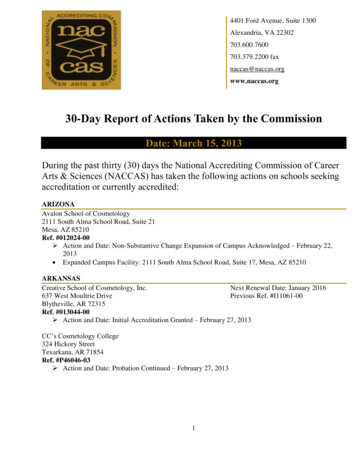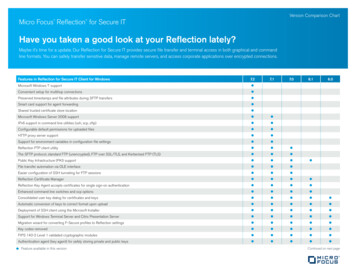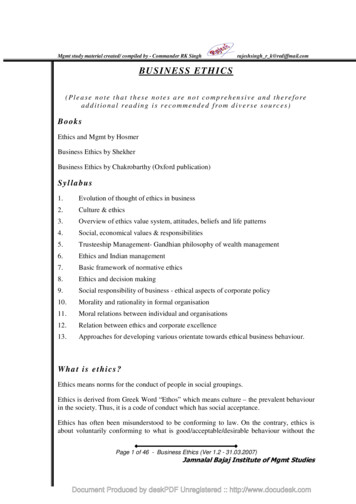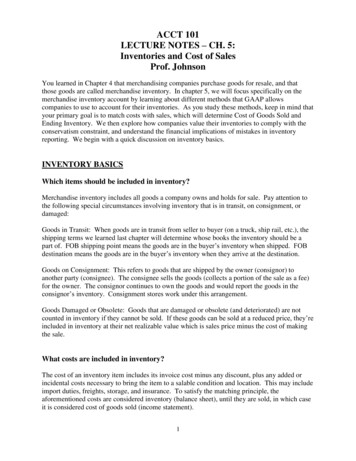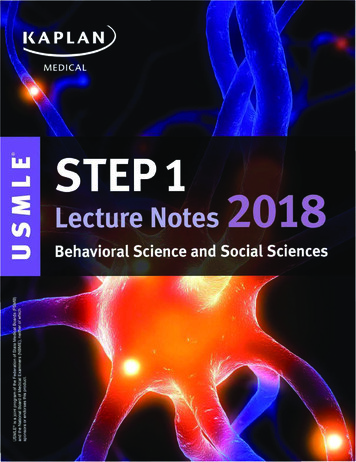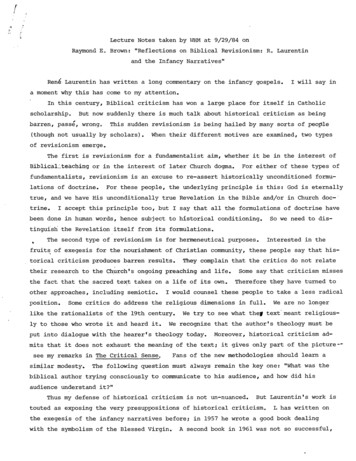
Transcription
Lecture Notes taken by WHM at 9/29/84 onRaymond E . Brown: "Reflections on Biblical Revisionism: R. Laurentinand the Infancy Narratives"René Laurentin has written a long commentary on the infancy gospels.I will say ina moment why this has come to my attention.In this century, Biblical criticism has won a large place for itself in Catholicscholarship.But now suddenly there is much talk about historical criticism as beingbarren, passe, wrong.This sudden revisionism is being hailed by many sorts of people(though not usually by scholars).When their different motives are examined, two typesof revisionism emerge.The first is revisionism for a fundamentalist aim, whether it be in the interest ofBiblical teaching or in the interest of later Church dogma.For either of these types offundamentalists, revisionism is an excuse to re-assert historically unconditioned formu lations of doctrine.For these people, the underlying principle is this: God is eternallytrue, and we have His unconditionally true Revelation in the Bible and/or in Church doc trine.I accept this principle too, but I say that all the formulations of doctrine havebeen done in human words, hence subject to historical conditioning.So we need to dis tinguish the Revelation itself from its formulations.The second type of revisionism is for hermeneutical purposes.Interested in thefruits of exegesis for the nourishment of Christian community, these people say that his torical criticism produces barren results.They complain that the critics do not relatetheir research to the Church's ongoing preaching and life.the fact that the sacred text takes on a life of its own.other approaches, including semiotic.position.Some say that criticism missesTherefore they have turned toI would counsel these people to take a less radicalSome critics do address the religious dimensions in full.like the rationalists of the 19th century.ly to those who wrote it and heard it.We are no longerWe try to see what the text meant religious We recognize that the author's theology must beput into dialogue with the hearer's theology today.Moreover, historical criticism ad mits that it does not exhaust the meaning of the text; it gives only part of the picturesee my remarks in The Critical Sense.similar modesty.Fans of the new methodologies should learn aThe following question must always remain the key one: "What was thebiblical author trying consciously to communicate to his audience, and how did hisaudience understand it?"Thus my defense of historical criticism is not un-nuanced.But Laurentin's work istouted as exposing the very presuppositions of historical criticism.L has written onthe exegesis of the infancy narratives before; in 1957 he wrote a good book dealingwith the symbolism of the Blessed Virgin.A second book in 1961 was not so successful,
because it crossed from matters of symbolism into matters of history.Mary knew of Jesus's divinity from the Annunciation forward.L presumed thatL contended that one mustpresume this, if one is to do justice to the dignity of the Mother of God.But I saythat you can't use this principle of giving due honor to Mary in an historical, exegeticalbook.In any case, thanks to these previous two books, I was looking forward to L'snew one.Then two things happen to pique my interest even further.I heardaboutGeorge Kelly's book, whose character is Summed up in a review by Jerome Murphy O'Connor(cites review).Imagine my surprise, therefore, when I saw that L wrote the foreword!Next, I got a phone call from the NC Register, asking me about an alleged plot to pre vent the publication of L's new book in this country.An article subsequently appearedin that paper, with quotes from various publishers indicating that they had a low evalua tion of the book, and yet the hint of a plot was not altogether dropped by the writer.Finally, then, this summerof revisionism mentioned above.I got to read the book.(Cites the two subtitles)gesis and semiotics, 160 pp on historicity.to Lk, only 56 to Mt.I find in it both the typesIt contains 350 pp on exe Of the exegetical part, 293 pp are devotedThis is because L's interests are those of a Mariologist, andMt's account centers on Joseph.can repeat himself here.Moreover, L has done previous books on Lk, so heSo Mariology explains the disproportionately large emphasison Lk.Besides this basic disproportion, L's book is marked by a polemical character.Hecontends that scientific historical exegesis undermines the historical and religiousvalue of the infancy narratives.L lives in a dualistic world.On the one side, thereare the good authors who favor the historicity of these narratives and a high Mariology.On the other side are those — formerly Protestants but now many Catholics as well— whoreduce the gospel of Christmas to myth, who have accepted ideologies of rationalism,idealism, and positivism, who are guided by a systematic suspicion of the miraculous.I have four reactions to this polemical dualism.(1) In my country, I have metfew priests who, under the impact of historical criticism, have ceased to preach theChristmas story.As to the supposed deleterious effects of my Birth of the Messiah,I have gotten many letters thanking me for providing new ideas of what to preach on.(2)I wonder just who are all these Catholics who've taken up rationalism.all the foremost exegetes, do they include me?(Other names I didn't catch)Positivists?Schnackenburg?If they areLéon-Dufour?Fitzmyer?Does L have evidence that these men are rationalists?I think it's shocking to find such sweeping charges.(3) I don't see anyevidence of a suspicion against the miraculous.My problem about the historicity of theinfancy narratives has nothing to do with that.More about this in a moment.(4) Iwas surprised to find L claiming that his 1957 work on Marian symbolism had ecumenicalsupport.He cites a few names of people who agreed with him.But even among Catholics
there were those who didn't; Benoît and even McHugh criticized L's ideas.mentions or answers their arguments.ideas among the Germans.He neverMoreover, there was a massive rejection of L'sSo L's notion that there was an ecumenical consensus takingshape, before Catholic scholars turned to historical criticism and disrupted this con vergence, is groundless.An example of genuine ecumenical convergence is Mary in theGospel, but L never mentions it.Now for more examples of L's polemicism."rigorous,"Books he likes are called "exemplary,"often with indications of how long they are, so we will think them weighty;but books he doesn't like are slightingly referred to, as by putting the word 'critical'in quotes.Moreover, L is intent on exposing "presuppositions" —"systematic presuppositions," "fragile presuppositions."he often speaks ofBut look at his own massivepresupposition: that Mary lived on in the Jerusalem community and therefore could havebeen the source of the information in the infancy narratives.this.The NT says nothing aboutThere is no support for it in other historical sources.sition!So it is a pure presuppo L frequently uses the word 'fiction'; he claims that the critics with whom hedisagrees, and who speak of theologoumena, are proposing "fiction."this point.I shall return toL takes 'chaira' in Lk 1:28 to mean "rejoice," while most scholars take itto mean "Greetings"; but Lspeaks as though there were a plot against his translation.Similarly, Lk speaks of "eyewitnesses and ministers"; the majority view among scholarsis that he means witnesses to Christ's public ministry; the minority view— and it isdefensible— is that he means witnesses already to the birth of Jesus and John; but L,who takes the minority view, thinks the majority is "rabid" against his view.Fitzmyer isn't rabid about it (cites a passage)."excrements of historical exegesis."Well,At one point L even speaks of theSuch language I would rather leave where excrementis usually found.Worst of all, L misrepresents those whom he criticizes.For example,Fitzmyer is more radical than I am on the virginal conception —not a fact even in the mind of Luke.says thatLthat he thinks it wasBut in fact Fitzmyer agrees with me that Lk wasthinking of the virginal conception as a fact.At one point Fsays that my argumenton this is "forceful," but L translates him as saying that my argument is "forcé"!this context, let me come back to the term theologoumenon.InI have always spelled outwhat I mean by it; I mean the historicizing of what was originally a theological state ment —I have never said "fictional" historicizing.But L accuses me of this.He saysthat I think Lk put the Magnificat into his narrative in order to re-value Mary, as partof a design forging this fictional theologoumenon.Well, I do think that Lk put thecanticles in, but I said that I think they fit the historical characters.Furthermore,I reject as unlikely the thesis that the virginal conception is a theologoumenon, andI have said that the theory which holds that it is one is not an adequate theory.Yet
I am accused by L of holding this theory.Likewise I have expressed my doubt thatthe birth of Jesus in Bethlehem or His davidic descent can be taken as theologoumenathough I think the genealogy may be oneAnd there is in any case a vast range ofpossibilities lying between pure history and pure fiction.For example, certain historicalevents may have been remembered and handed down in a popular or figurative way, so thatthe result is no longer "history" but is not "fiction" either.L also misrepresents me by saying that I make the Virgin Mary symbolic rather thanhistorical.L bases this charge upon a passage in which I am discussing the views ofPannenberg; he had held that the NT tells us very few facts about her, and that thedevelopment of Marian doctrine was therefore based primarily on the figure she presentsas a symbol; I agree with him that the NT provides very few facts and hence that she lendsherself to symbolic treatment.of Mariology —not exegesis.But this whole discussion of mine was about the principleIf Lthinks he can extrapolate from the one topic to theother, his view of exegesis must be very different from mine (i.e. L must differ fromBrown over how far one’s exegesis can and should be kept independent of one’s theologicalprinciples?).Enough of the negative.What is good about L ’s book?semiotic, in which there are many points of interest.Well, there are 290 pp onBut I think that the results ofL ’s semiotic treatment yield little that would change the basic picture of the infancynarratives, as that picture has already been drawn by historical exegesis.Of course,semiotics is very French movement; I don’t think I am French enough to dabble in it.So let me quote a French reviewer of L ’s book (quotes from a review by someone with aname which sounded like Mondeboux)to the effect that the tidal wave of semioticshas reached its peak and begun to recede, leaving a few beaches changed in shape butthe coastline unaltered,The basic picture remains unchanged because, whatever the merits of semiotics, L'sarguments for basic changes in the critical picture are invalid or fanciful.—Namely:one of L ’s arguments in favor of the historicity of the infancy narratives isthat, if the evangelists had been inventing them out of whole cloth, they would havefollowed general Jewish conceptions and presented Jesus as simply coming down fromHeaven.But there is no evidence that such a descent of the Messiah from Heaven was infact a Jewish expectation; so there is no reason to suppose that the evangelists, iffree to create, would have written such an account rather than the sort of account wenow have; so L's argument is invalid.—L says there was firm local tradition at Nazareth that Jesus was not the sonof Joseph; he instances the "constant avoidance" of the phrase, "Jesus son of Joseph,"except on the lips of Jesus’s adversaries.look at John 1:45.But this alleged avoidance does not exist:
—L interprets 'kecharitōmenē' the way St. John Chrysostom did, and he defendsthis procedure by saying that Chrysostom certainly knew his Greek.I ’m sure he did,too, but such a defense cannot stand because Chrysostom, besides his knowledge of Greek,was basing his interpretation on four centuries of Christian doctrinal developments (hencehis ideas may be conceptually anachronistic?).—L argues that Gal. 4:4 alludes to the virginal conception, becausephrase "born of woman" would be unnatural.man"?(Laughter.)otherwise theWould it be more natural to say "born of aBut I do not rest my objection on that point.Rather, there is muchevidence that "born of woman" was a standard Jewish expression, and L presents no evi dence to the contrary.—Luke doesn’t mention Mary in his passion narrative, but L thinks that Lk meansfor us to understand that she was there.is "dans la manière de Luc."L says that this hidden allusion to the VirginBut this is pure fantasy "dans la manière de Laurentin."(Laughter.)—In dealing withthe story of the finding of t h e child Jesus in the Temple, Lsimply presupposes the foreknowledge of Jesus.—As to the phrase, "I do not know man," in Lk 1:34, L argues that it is a statementof permanent c o m m i t m e n t ,like "I do not smoke." (Laughter.)But L does not bother to studyother annunciation stories to examine the nature of the objections advanced in them.If hehad, he would have seen that the objections deal with current obstacles, not necessarilywith permanent or future intentions.—L points out that, in the ancient world, there really were astrologers who watchedthe stars, that they made political deductions from their observations, that Herod was acruel king, etc. —all to make the point that M t ’s infancy narrative has verisimilitudeand hence should be taken as historical.historicity.The trouble is that verisimilitude never provesAfter all, a forger or writer of fiction will also try to imitate fact.Hence verisimilitude only proves plausibility.—L observes that the prophecies quoted in Mt's infancy narrative do not mesh verywell with the events which are supposed to be their fulfillments; he then argues that, ifMt were making up the events, he would have made them fit the prophecies better; thereforethe events must be real.But this failure to mesh is exactly the reason why most criticsthink that Mt inserted the prophecies into a pre-existing narrative; it proves nothingabout the historicity of that narrative.—L fails to face this alternative.L boldly asserts that there is simply no need to reconcile the infancy stories ofMt and Lk, and hence makes no attempt to do so.He thus evades in a purely rhetorical waywhat is really the major problem about taking these stories as historical.Certainly thedivergence of the two accounts is why I have trouble taking them as historical —fact that they contain miracles.not the
—From the mere fact that Lk 1:32 mentions the title 'son of the Most High' beforethe title 'son of David', L jumps to the conclusion that Lk knew (or his informant knew?)the mystery of Jesus's divine filiation.—L admits that "Paul was not without conceptual embarrassment" over the virginalconception.—(Point of this item unclear)As to the Canticles, L defends their exact historicity not only by assuming thatMary composed one of them (the Magnificat) but by advancing the idea that she memorizedthe other two (Benedictus and Nunc Dimittis) upon first hearing! (Laughter.)—L argues that Lk couldn't have created his infancy narrative, because it is tooprofound.Only a soul supremely steeped in contemplation, like that of the Blessed Vir gin, could have produced it.—This is hopelessly subjective.L argues that Mt and Lk would naturally have searched for information about theorigins of Jesus.If they searched, why would they have found nothing?something, why would they have resorted to fiction?And if they foundThis reasoning is invalid because,again, L sees no intermediate possibilities between fiction and pure history.—Even Card. Daniélou failed at one point to satisfy L's demand for historicity:Daniélou conceded that the song of the angels (Lk 2:14) might have been composed and in serted later.Labouré.L counters this lapse by appealing to the experiences of St. Catharine(Laughter.)In sum: this book is fanciful —beyond the pale of Biblical criticism.Yet, despite everything, I think that L and I agree on the following significantpoints: that the infancy narratives are True Gospel, that they are poetically sensitiveaccounts, that they shouldn't fall victim to rationalistic treatment, that they shouldn'tbe dismissed as "myth" or "fiction" in the layman's sense of those words, and that theygive us a high Christology.L's readers would get the impression that I disagree withhim on these points, but I don't.certain narrative details.unhistorical.I really only disagree with him on the historicity ofEven as regards these details, I do not assert that they areI don't even say that there were no Magi.ficulties against taking these details as historical.Therefore, if you are going toassert their historicity, the burden of proof is on you.prove it.I only say that there are dif You will have to be able toThis is what L cannot do.In my opinion, you can be a respectable Christian scholar whether or not you believethat there was a star, a visit of Magi, a flight into Egypt, etc.I have not claimed thatany of these things is unhistorical; I simply don' t know whether they are or not.But thevirginal conception is another matter: I have said that it is a dogma of the Church.In conclusion, I agree that L has written "a significant book" —the one he wrote in 1957.but that book isHis new book is just revisionism of the first type; as an at-
tempt at revisionism of the second type, the new book is a revisionism manque.Questions from the AudienceQ. Has Fr. Eamonn Carroll read and responded to Laurentin's book?A. I don't know? I have great respect for Fr. Carroll.Q. Do you know Laurentin personally?A. Never met him.Q. Why doesn't he ever come to our conventions and talk to his peers?A. Laurentin is a Mariologist, not a Biblical scholar, so it's not surprising that he doesn'tcome to conventions in our field.Q. What the devil is this "semiotic"?A. That is very hard to explain.It involves looking at the number of occurrences of eachword and in what combinations the author uses it.It can get rather mathematical.Wehad a paper on it at the SBL a few years ago? the author conceded that the results ofsemiotic analysis might seem slight to us, but this is because the method is stillwaiting to make some further break-throughs.Q. The infancy stories of Mt and Lk seem very different? it's hard to see how they couldmesh.Just how different are they?A. Yes, they are very different, and this is the real problem about their historicity —not the miracles.Apart from the virginal conception itself, the only points Mt andLk agree about is that the birth took place in Bethlehem, and that a name was pre announced by an angel.Beyond that, things diverge sharply.There is also a majorproblem about the accuracy of the time-frame Lk sets up: Quirinius was not governorof Syria at any time while Herod the Great was alive.Q. I am surprised that you have not made a strong attack on semiotics? you seem noncommittal about its merits, in a spirit of methodological ecumenism.Yet you said thatthe crucial question for interpretation was what the author consciously intended toconvey, whereas semiotics insists in principle that the author and his intentions areto be set aside.If you chose to attack semiotics on this ground, you would have S.Hirsch, The Validation of Interpretations, on your side.A. I am not familiar with that book.But you are right that I take a neutral attitudeas regards semiotic method, and I do so because I acknowledge that a text can conveypoints outside the conscious intent of the author and can take on a certain life of itsown.- -Comments by WHM.(1) Brown read from his prepared text at a rapid clip and in a far from booming voice;
hence it was very difficult for the note-taker to keep up with him. Titles of booksand Journals went by too fast for me to catch. Throughout the above notes, I haveused parentheses to enclose reportorial comments or summaries; if the parentheticalmaterial ends in a question, it represents a conjecture on my part.(2) A further point of importance for the content of Brown's position emerged in adiscussion which Brown had with one of my students on the way out of the auditorium.Brown had said (as you see above) that he takes the virginal conception to be a dogmaof the Church. I had alerted the student to the fact that, in previously publishedmaterial, Brown had eviscerated this sound-looking declaration by going on to wonderwhether the Church's dogma includes a biological facto So the student put the ques tion to him directly: "Does this dogma include a biological fact?" Brown's reply was:"I think it does." The implication clearly seemed to be that a contrary opinion wasconceivable, "respectable" or tenable within the Church. So I am tempted to compareFr. Brown's position to that of Gov. Cuomo: "I am personally opposed to denying thatthis dogma contains a biological fact, but I will not impose my views on others."(3) The reaction of Brown's audience was overwhelmingly favorable, of course. Theytook his speech as a witty, incisive, even devastating review. My own students (fiveor six of whom attended, and who were all antecendently opposed to Brown's general views)were no exception. I had to win them back to Laurentin's side, more or less, afterwards,by explaining to them the hidden tacticin Brown's address, by which he had managedto create such a devastating effect.The tactic, of course, was se lective quotation. Brown had said that Laurentin attacked the "presuppositions" ofhistorico-critical exegesis, but he never quoted any of the lengthy passages in whichLaurentin spells out this attack. Apart from an allusion to "sweeping charges" ofrationalism, positivism, etc., Brown's audience could form no picture of what Lauren tin's challenge to the critics amounted to. They could not guess that very definitealternatives to certain very definite tendencies of the critics (such as the tendencyto posit behind every text another text or tradition, never an event) were being ad vanced by Laurentin and cogently defended. This silence on Brown's part, as to thefoundations of his opponent's position, served his rhetorical purposes in two regards.On the one hand, it allowed Brown to present a long series of Laurentin's argumentsas "fanciful" lapses from critical orthodoxy, rather than as what they really were:forms of argument which Laurentin had carefully legitimated in his critique of criticalorthodoxy (and which are accepted among historians in other fields in any case). Inother words, Laurentin had made a serious effort to wrench the reader's mind out ofcertain conventional ruts and into a perspective from which these arguments could re gain their natural force. Brown, by hiding that effort from his audience, made thearguments fall upon unprepared ears, and upon minds still accustomed to the ruts.On the other hand, and more deeply, Brown's silence allowed him to avoid confrontingthe real issue between himself and Laurentin, hence allowed him to perpetuate the il lusion that he has a secure bailiwick, into which a stranger has lucklessly strayed.Indeed, the fundamental strategy of Brown's address was to "review," in his capacityas expert exegete, Laurentin's book as the adventure of a Mariologist erring outsidehis field. This strategy required an absolute refusal to acknowledge that the bookhad called the reviewer's expertise into any sort of question. Hence, by adoptingthis strategy, Brown simply declined the intellectual opportunity which the book af forded: the opportunity to admit that precise points of his critical method itself(not just its results) had come under methodological challenge (not just pastoral,theological, or fundamentalist challenge), and to state that challenge frankly, and toanswer it frontally. Of course, for those of us who have been watching Brown over theyears, this shrinking from theoretical challenge can hardly come as a surprise. He hasmade his career by mastering the "consensus" of critical exegetes, taking it as a
"given," and by adapting himself to it? his emergence as a world-class exegete hasbeen the success of a chameleon. Nevertheless, despite the predictability of itsstrategy, Brown's address must be called a disappointment. The Catholic heritage oftheology is an immensely sophisticated one; those who wish to introduce into it a su pine acceptance of the post-Protestant critical consensus must sooner or later facetheir theoretical challengers. When they do, I am far from supposing that men likeBrown will be easily vanquished. They have much to say in their defense. Our debatewith them is likely to involve partial victories on both sides. But that is preciselywhy the time is overdue for that debate to begin. Brown's strategy of delay is dis appointing just because it is ultimately futile.(4) I also told my students that the tone of theological moderation (even conserva tism) which they were hearing from Brown, and which surprised them of course agree ably, was also not to be trusted. Such a tone is again part of his strategy: theerrant stranger in the field must not be allowed to cry alarm. In the secure baili wick of the exegetes, all must be seen to be prudent, moderate, sensible, and even(in a robust, large-minded sense of the word) orthodox. The stranger's complaintsof exotic error (positivism? idealism?) must be made to appear groundless. This ispartly done by distorting the complaint (Laurentin had said that the critical methodhad its roots and justifications in certain 19th century systems of philosophy, butBrown distorted this into the charge that critical exegetes had become converts tothese forgotten systems!) and partly done by exuding an air of doctrinal safety.Yet Brown could not entirely succeed in hiding beneath this conservative veneerthe alarmingly radical sub-structure of his position. My students caught a glimpseof it at the point where Brown was distributing the burden of proof: the historicityof the star, the Magi, etc., is in suspense, but the burden of proof lies on thosewho wish to assert it. This had struck my students as odd. To them it seemed intui tively clear that a Christian would give the benefit of the doubt to the Gospel text?its historicity might be uncertain in some details, but the burden of proof wouldlie on him who denies it. I helped them to see that their intuition was sound andthat it rested upon the Faith? they were allowing their faith to apportion the bur den of proof. Brown was allowing the "consensus" of critical exegetes to appor tion it. And this very fact does much to reveal the nature and basis of that consen sus, as Brown understands it. For him, to practice the craft of the exegete is toenter a special terrain, over the gate to which are inscribed the words, "Lasciateogni fede, voi ch’entrate."Sometimes Brown speaks as though he only meant to saythat the Catholic exegete should keep his exegetical work clear of his theology —a position which makes a good deal of sense. Theological systems and speculationsneed to be validated against the independently arrived-at data of exegesis; for thispurpose, exegesis ought to be theory-neutral rather than theory-laden. But it isall too clear that Brown really means to say something much more dire — that aCatholic exegete ought to keep his work clear of the Faith itself — ought to abstainfrom using even dogmas as keys to understanding the message of the text. This is direbecause, to a Catholic mind, dogmas are not theories but facts. To ignore them orpretend "methodologically" that they don’t exist would be the very opposite of scien tific procedure! To be sure, there are times when a Catholic exegete is called uponto perform an apologetical task; and in that mode of operation, he must see to itthat his argumentation does not rely upon the faith in any way which would deprivethe argumentation of probative value in the eyes of the non-Catholic. But has theexegete no other mode of operation? Is he never "hearing the text" in the con structive mode of positive theology? Laurentin thinks that this second mode ispossible; it is the very mode in which he writes. Thus, in understanding the storyof the Finding in the Temple, Laurentin avails himself of the fact that Jesus pos
sessed foreknowledge. "Foul!" cries Brown, who sees a violation of exegetical methodin any such use of dogma. No further indication is needed that, for Brown, exegesis(real exegesis, not pious meditation) cannot be an exercise of positive theology. In deed, exegesis for Brown cannot be one of the sacred sciences at all. For Brown’sworks are certainly not apologetics. His own books and those of the exegetes he ap proves do not fit the description of any Catholic discipline, as traditionally under stood. If one wishes to find a parallel in history to Brown’s idea of a faith-indepen dent exegesis, one will have to go back to the faith-independent philosophy of JakobFrohschammer (see D-S 2850ff.). Indeed, there is not only an intellectual parallel, Ithink, but a sociological one. Frohschammer saw a thriving profession, a kind of guild,of German philosophers, and wanted to join the profession on its own terms. Brown sawa thriving profession of historico-critical exegetes and wanted to join it on its terms.Having been accepted into membership, he allows the profession to distribute the burdenof proof. This distribution will be very often disadvantageous to Catholic beliefsbecause, inside the profession, Catholic dogmas are seen as unscientific theories aboutwhat the Biblical text means. (It is conceded that scientific theories which go someway to support Catholic dogmas can be elaborated, but they are not considered too safe,and hence an exegete is
Raymond E. Brown: "Reflections on Biblical Revisionism: R. Laurentin and the Infancy Narratives" René Laurentin has written a long commentary on the infancy gospels. I will say in a moment why this has come to my attention. . As to the supposed deleter




